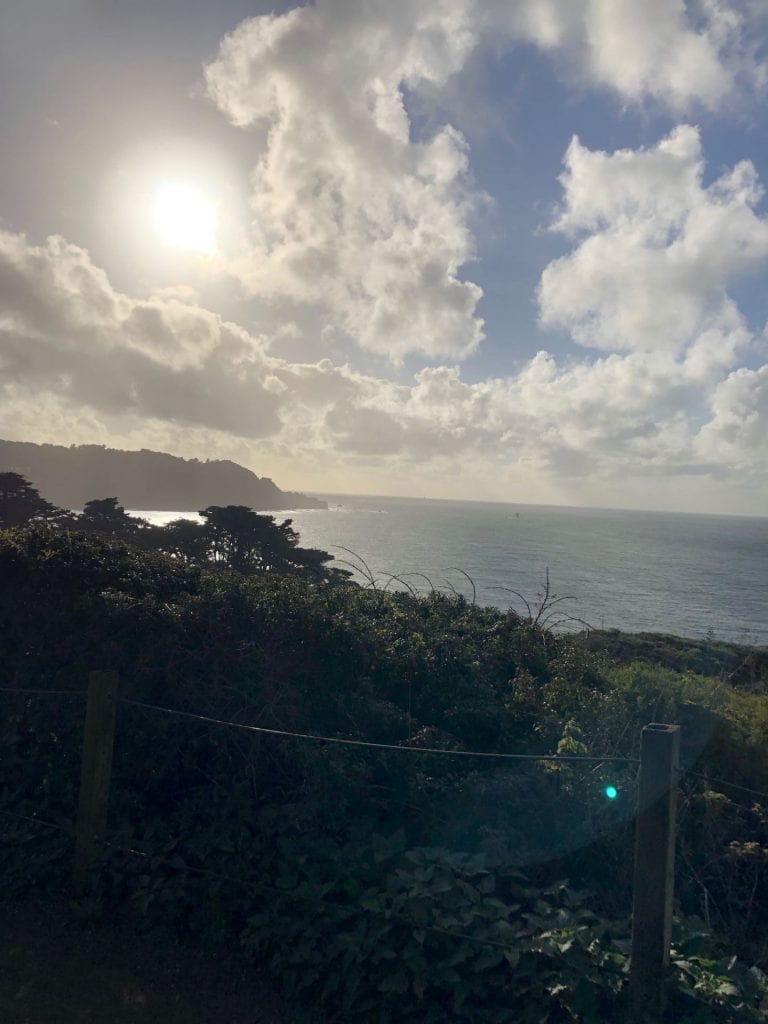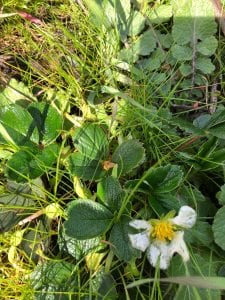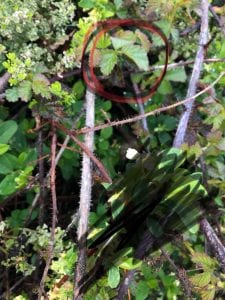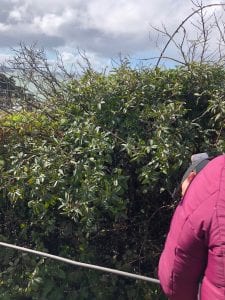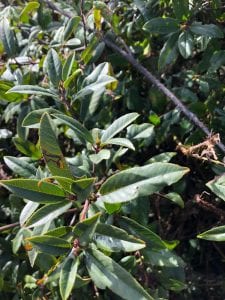Location: The Presidio (That big park next to Golden Gate Bridge)
Use the map above to find out how you could see the same plants I did!
Hello Everyone!
This week we went to the Presidio and it was amazing! Sometimes I associate it with being a little touristy, but that certainly wasn’t the case in the place where we visited the Presidio. I didn’t end up seeing nearly as many people as I thought I usually see around there. However, the lack of people we saw probably had something to do with the intermittent rain. The cold winds plus little water projectiles running against your face was not the most pleasant thing in the world. However, as it turns out, the cold wind is actually one of the reasons why the Presidio looks the way it does! All of the plants in the area have cool adaptations to prevent them from desiccating and losing all of their water. As a result, it made the plants here quite a sight to see! In addition, even though the primary habitat in the area was coastal, we also got to see some cool serpentine rock outcrops. These rocks are generally quite hard to live on because of all the heavy metals inside of them but that also means they have some pretty cool plants around them.
****
Sandy Berries
I’m sure that most of us have fond memories of beach days with our friends or family (and if you haven’t then you need to). However, there is one Universal problem that exists amongst humanity on beaches. That problem is getting sand on your food. No matter how well you pack your cooler or how much plastic wrap you put around your sandwich, sand will find its way between your teeth. That’s the reason why the first plant I will be introducing is so interesting. Fragaria chiloensis or the Beach Strawberry is a strawberry plant that grows on coastal soils which are dangerously close to the sandy beach. What’s worse is that these strawberries grow VERY close to the ground. As a result, it is almost a guarantee that you will get sand in your mouth if you ever attempt to eat one. It’s almost like nature set up some sort of cruel joke or something.
Despite this one unfortunate setback to the plant, it is apparently still sold in many South American markets as a delicacy. This plant’s Strawberries are known for their very large size and flavor. Another fun fact about this plant is that the berries were actually so large that this species of strawberry was crossbred with Fragaria Virginiana to form the modern garden strawberry (Fragaria Ananassa) that we all know so well. Aside from its taste, the beach strawberry also a very big, beautiful and prominent white flower that would make it a welcome addition to any garden. Unfortunately, I didn’t get to see any big beach strawberry plants, but the small ones were still cute anyway.
Plant Description (Fragaria chiloensis): These plants have a generally dioecious habit. Their stems grow to be between 5 and 20 centimeters. Their leaves occur in a trifoliate arrangement and are very thick. The adaxial side of the leaf is glabrous and waxy in appearance. The abaxial side is very densely hairy. Their shape has a unique obovate form to it. The leaves also have a serrate margin to them which might make them look hostile if it weren’t for the large flowers they produce. The plant is so small and low to the ground that the inflorescence of this species is considered to be “exceeded by” its leaves. The iconic white flower typically has 5 petals in its corolla 10 to 18 mm wide. It has around 20 to 35 stamens and multiple pistils. Additionally, the petals have a cool “unlobed hypanthium bractlets” shape to them. The fruit it produces is considered an achene. This means that the “seeds” on the outside of the strawberry are actually the ovaries and each one is considered to be a separate fruit. Lastly, this plant has the ability to reproduce through its seeds, extending rhizomes or extending stolons. This means the plant can extend its stems or its roots horizontally to make new plants.
****
Thorny Berries
Blackberries are probably only my fourth favorite berry, but are still very tasty nonetheless! Luckily, we also saw some California blackberry (Rubus Ursinus) on our adventure. However, just like the strawberries, nature seems to have played a cruel trick on us. In order to get to the tasty blackberries, you must fight your way through a tangle of thorny vines. Blackberries are in the Rosaceae (Rose) family and unfortunately inherited the same thorns that roses possess. At least it makes the taste that much more rewarding after you finally get past all of the thorns. In fact, I should actually count myself lucky, because I could’ve accidentally run into the more prevalent invasive Himalayan Blackberries. This invasive species of Blackberry actually makes the thorns of the California blackberry look like my dog’s cushy overused bean bag. I once had to weed out some of them in a community park and I had so many pricks on my arms that it looked like I had chicken pox. Unfortunately, the Himalayan blackberries grow in large thickets that cover the ground and strangle many other native species out, including the California Blackberry.
One fun fact about the California blackberry itself was that it was actually viewed to have medicinal properties by native Americans. Infusions of blackberry roots and leaves were made to treat rheumatisms and diarrhea by some tribes. Today, not many scientific inquiries have been made into the Rubus genus to see if these plants actually have medicinal qualities, but it would be cool to see the possibility explored someday!
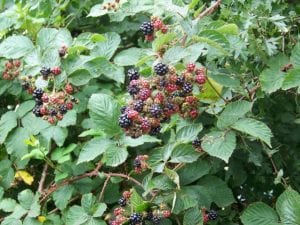
Plant Description (California Blackberry) (Rubus Ursinus) (bottom photo): The California Blackberry’s habit is decumbent. This means it lies along the ground. It also has small prickles. In addition, the plant is generally dioecious. It typically reproduces after the second year of growth. The leaves of the plant can be compound or simple. If they are compound then they occur as either 5 or 3 leaflets. The arrangement of the leaflets is terminally triangulate and their shape is ovate with an acute tip. The margins on the leaves are somewhat irregular. Interestingly, the plant also has a cyme inflorescence. The corolla of the flower is white and has an elliptical shape. Also interesting, the female flowers typically have over 30 pistils inside of them. In addition to reproducing through seeds, California blackberry can also reproduce using its stolons.
****
FAKE Berries
One day during high school, I was sitting in history class. My history teacher had just begun teaching us about the Holy Roman Empire when she told us “despite its name, The Holy Roman Empire was neither Holy nor Roman nor an Empire. They just wanted to be like the Roman Empire”. I remember thinking to myself that I can see the reason why these people decided to name themselves the Holy Roman Empire, but at the same time it just felt like a horrible name because they were living a lie. The same principle applies to the third and final plant I am showcasing, the coffeeberry (Frangula californica). When I hear the word “coffee”, I expect a caffeinated, artisanally crafted drink with a delicate heart-shaped milk foam top. When I hear the word “berry” I think of a delectable, juicy, packet of deliciousness that will probably end up staining my shirt. Coffeeberry is decidedly neither of these things. In fact, it looks like a relatively boring plant. Yet, the plant’s name and even its overall morphology were so misleading that it aggravated me to the point where I felt like I had to include it in my post.
Here’s my not-so-fun fact about the coffeeberry. The bark gives you diarrhea. Don’t eat it. It’ll just give you another reason to be mad at it. The native Americans in the area used it as a laxative, but I’m sure they did so very begrudgingly. Also, I heard from a few other forums that some people actually try using coffeeberry seeds as a coffee. Apparently, it does taste vaguely of coffee mixed with chocolate. However, this concoction may also disappoint you because there is no caffeine in coffeeberry seeds. :/
Plant Description (Frangula californica) : The habit of this plant is that it is a shrub. Usually, the height of the shrub does not exceed 5 meters. The stem’s bark can be a variety of different colors, including grey, brown, and red. The terminal bud also has a cool velvety texture to it. The leaves are generally elliptical/ovate. Their tips are acute and their bases are rounded. This plant’s flowers are very small at only 1-2 mm wide. They also have a hypanthium shape but aren’t super noticeable. They’re fruits are stoned, kind of like peaches and resemble actual coffee fruit. In addition, they can be either black or red in color.
****
Thanks everyone for checking in on my class adventure this week! I’ll be back for some more culinary adventures next week! This week was a blast, even if it did rain!
